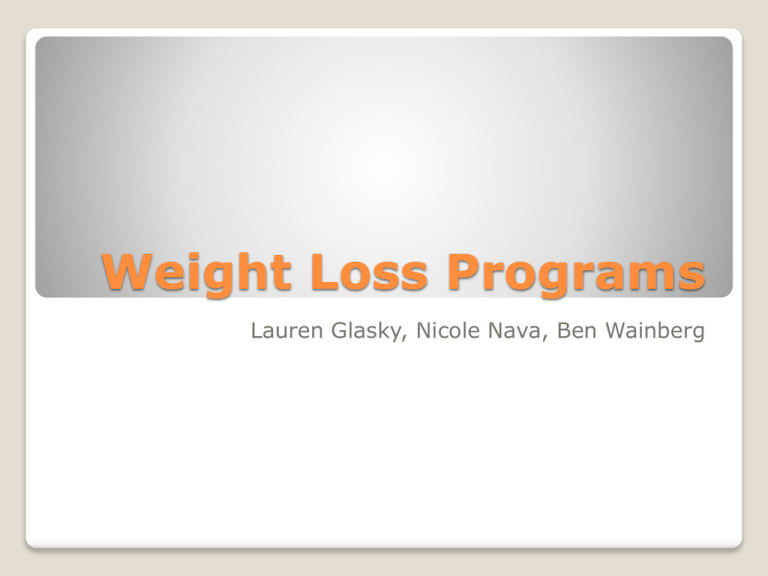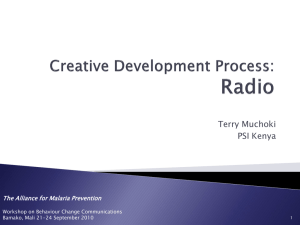
Weight Loss Programs
Lauren Glasky, Nicole Nava, Ben Wainberg
Agenda
Industry Overview
Major Players
Primary Advertising Methods
Raw Data Analysis
Recommendations
Why Weight Loss Program Industry?
Growing industry because:
Industry Overview
Industry Overview - Definition
Multi-billion dollar industry
Provide nonmedical services to clients to assist them in losing weight or
maintaining a desired weight.
Services typically include individual or group counseling; menu and
exercise planning; and weight and body measurement monitoring.
Industry operators may also sell food supplements and other weight
reduction products.
This industry does not include fitness centers, health resorts and spas or
medical or surgical weight reduction services.
Industry Overview - Activities
Primary Activities
•Operating nonmedical weight loss centers
•Individual or group counseling for weight loss
•Diet workshops
•Selling food supplements and other weight reduction products
•Menu and exercise planning
•Weight and body measurement
Major Products and Sales
•Merchandise sales
•Weight loss services
•Other
Who are the main competitors?
Industry Overview & Structure
HHI = 1,915.74
Four Firm Concentration = 67%
Number of Businesses = 24,901
Industry Overview - Barriers to Entry
IBISWorld rates the degree of barriers to entry as: low and steady
Barriers
- High Competition
- Medium concentration
- Mature Life Cycle Stage
Mitigating Factors
- Strong consumer demand because an
increasing number of Americans are
overweight or obese
- Low level of capital needed to enter the
industry
Industry Overview – Technology & Systems
Level of Technology Change has been Medium
Greater use of telephone and online services to deliver advice, ordering,
etc.
◦
More companies operate delivery-based weight loss services through an online
platform
Industry Overview - Industry Assistance
Level of Industry Assistance and the
trend is Medium and increasing
Tax deductions available for individuals
who have conditions (i.e. heart disease,
hypertension) that could benefit from
weight loss treatment.
Industry Overview - Industry Performance
Life Cycle Stage: Moderate growth
Stable number of
companies are
operating in the
industry
Worsening health trends
and improving economic
conditions are
increasing demand
Relatively untapped
market of men's
weight loss
Increasing external
competition from medical
centers
Industry Overview - Competition
Competition is high and increasing
Internal Competition
• Based on price, quality of service, effectiveness and advertising
• WOM and online reviews key to developing a steady revenue base
• Marketing and advertising are key to generate sales
External Competition
•Do-it-yourself methods are most common substitute
•Medical services offering weight reduction surgery.
•Weight loss pills
Industry Overview - Key Success Factors
Ability to
franchise
operations
Ability to
effectively
communicate and
negotiate
Undertaking
technical
research and
development
Ability to
provide
goods/services
in diverse
locations
Receiving the
benefit of WOM
recommendation
Willingness to
outsource when
appropriate
Industry Growth
Annual growth 07-12 = -2.4%
Expected Annual Growth 12-17 = 2.5%
2012 Revenue = $2.7 billion
2012 Profit = $313.3 million
Factors of weight loss program consumption
Healthy Eating
Index
Per Capita
Disposable
Income
National
Unemployment
Rate
Demand from
Offices of
physicians
Success?
2004 - Present
Google Trends: Analyzing
2010
Major Market Segmentation
Women are the largest purchasers of industry services
◦
Make up over 85.0% of members
◦
70 million people are on a diet – 20 million are men
However, higher percentage of American men are overweight or obese
Spending on weight loss services also varies depending on a consumer’s age.
Business Locations
Dependent on population levels, as well as obesity rates and disposable income levels
The Southeast
◦
26.9% of industry establishments
◦
Highest obesity rates: Kentucky,
Louisiana, Mississippi and Oklahoma all
have obesity rates over 30.0%.
Mid-Atlantic
◦
17.6% of industry establishments
◦
Region has slightly higher-than-average
per capita income level, making
consumers more likely to spend on
discretionary services.
West
◦
~16.5% of industry establishments
◦
California, alone has 13.2%
Great Lakes
◦
13.4% of industry establishments
Business Locations
Regulations
Regulation in the industry is Medium and Steady
◦
The FTC regulates laws related to advertising, disclosures to
consumers, privacy, consumer pricing and billing arrangements.
◦
Individuals under legal age require parental or guardian before
beginning a professional weight loss program
Major Players
Major Players
Weight Watchers
Nestle (Jenny Craig)
Nutrisystem
Weight Watchers
Market Share = 39.4%
Began in NY in 1963
As of 2012, has 1.3 million members
Meeting fees make up over 54.0% of the company's
revenue
Sells products (bars, snacks, cookbooks, food and
restaurant guides) – 15.4% of revenue
Internet revenue – 22.0% of revenue
Jenny Craig
Market Share = 11.6%
Founded in 1983 in Melbourne, Australia
Now owned by Nestle
Has provided services to more than 5 million members
Offers 80 entrées and snacks to clients
Sells videos, cookbooks and exercise accessories
Consultants offer advice and encouragement to members
Nutrisystem
Market Share = 15.1%
Established in 1971
Typical customer is female and about 50 years old
Offers home-delivery meal program with low-calorie and
portion-controlled meals
Counselors are available to answer questions and make
recommendations to clients (online tools and counseling)
Primary Advertising
Methods
Informative Advertising
Price
Ease
Disclaimers
Methods of Access
◦ Website
◦ Phone Number
Science and Health
Science in Weight Loss Ads
Nutrisystem uses the science of the "glycemic index" to
differentiate "good carbs" from "bad carbs"
Celebrity Endorsements
Weight Watchers "Expect Amazing" Campaign
Use of celebrity endorsements (Jennifer Hudson, Jessica
Simpson)
Mention new "Weight Watchers 360" program which is "built
for human nature"
Relate to people who have failed at diets before
Mention typical "non-diet" foods that you can eat on the
program
Expect Campaign
Average People Testimonials
Include Emotional Stories
Try to relate to audience they are targeting
Explain Product Attributes through
narrative
"The I'm only human and I did it Project"
A compilation of video blogs from average people (and
celebrity endorsers) giving unedited and unfiltered
testimonials of their successes with Weight Watchers.
As an experience good, these ads strive to enhance
perceived quality and credibility of the service
Targeted Audiences
Young Women
Mothers
Men
Targeting Moms: "We Know Moms" Campaign
Launched by Jenny Craig with actress Nicole Sullivan
Targeting Men: Weight Watchers for
Men
Feature celebrity NBA player Charles Barkley
Frequent use of humor
Mention of typical "man foods" such as beer, wings, pizza
Break stereotype that diets are for women
Humor Ads
Less common
Used more for ads targeting men
Charles Moment
Emotional Benefits
Important for an Experience Good
Confidence
Happiness
Reclaimed Youth
Love Life
Typically used in testimonials and are
important for an Experience Good
Valerie Bertinelli for Jenny Craig
Product Placement
Food Appeals
Visuals
Recipes
Branded Food
Sex Appeal
Before and After
Improved Sex Life
Nutrisystem Campaign "A Different Approach"
One testimonial:
◦ "Since nutrisystem, my sex life is excellent."
Another ad questions:
◦ "Has your sex life slowed down or come to a screeching
halt?"
Internet Advertising
Website with Online Tracking and tools
Special Online Ads only and Video Blogs
Online Calculators
Weight Watchers’ Ana Gasteyer Online Campaign
Exclusive online campaign featuring celebrity
comedian
Different approach from the usual uplifting,
inspirational spokespeople that are normally used
Social Media
Comparative Ads
Weight Watchers Comparisons
◦ 'No Counting!'
Nutrisystem Comparison Website
Advertising Expenditures
Weight Watchers
◦ 2012 Advertising and
Marketing Expenditures
$27,437,000 (Source:
Mergent Online)
◦ 2012 Ad-to-Sales Ratio
of 18.31%
Raw Data Analysis
Advertising Strategy Data Analysis
1. Collecting Raw Data
Watch a variety of commercials to get a feel of
the industry and possible strategies
◦ create a comprehensive list of these strategies with a
coding mechanism
0= no use of the strategy
1= use of the strategy
Continuous count method also used for product characteristics
Advertising Strategy Data Analysis
2. Watch Advertisements
◦ Weight Watchers= 10 Ads
◦ Jenny Craig= 10 Ads
◦ Nutrisystem= 7 Ads
Coding scheme was employed while we watched the ads
3. Analysis of the Raw Data collected
Results from Analysis- Weight Watchers
Weight Watchers differentiates itself from
competitors by more often employing
these strategies in ads:
◦
◦
◦
◦
◦
◦
Real People
No mention of actual pounds lost
Mobile App Mentioned
Musical ads
Humor ads
Targets Men
Results from Analysis- Jenny Craig
Jenny Craig differentiates itself from
competitors by more often employing
these strategies in ads:
◦
◦
◦
◦
◦
Testimonials
Waist size/dress size mention
Use of emotional stories
Support System
Targets Mothers
Results from Analysis - Nutrisystem
Nutrisystem differentiates itself by more often employing these strategies in ads:
◦ Celebrities
◦ Average pounds lost was over
20 lbs
◦ Website mentioned
◦ High Product Characteristics
count
◦ Mention of "non-diet" foods
◦ Disclaimers
◦ Before and Afters
◦ Mention of benefits other than
weight loss
◦ Price
◦ Special Offers
◦ Own Branded Food Mentioned
◦ Ease of Use
◦ Visual of Foods
◦ Science of weight loss
◦ Variety
Celebrity
Targets Mothers
Targets Men
Real People
Waist Size Mention
Emotional Stories
Humor
Price
Mentions Health Benefits
Ease of Use
Support System
Mention Non-Diet Foods
Investment and
Advertising
Recommendations
Investment Strategy
As with any investment, one must evaluate their portfolio and
risk/return preferences
That said, of the three, we would invest in Weight Watchers
◦ US based (Nestle based in Switzerland)
◦ Performing well and growing (less risky than Nutrisystem)
◦ Most flexible option to fit into everyday life
Recommended Advertising Strategies
Appeal to Older people
◦ Nutrisystem expected to expand food system
and advertise the nutritious nature for aging
bodies
Appeal to Children
◦ Obesity in children is a growing epidemic.
◦ According to the CDC, it has more than
doubled in the past 30 years
Appeal to Men
◦ Higher percentage of American men are overweight or
obese than adult women
Questions?
The End











